The Great Pyramid of king Khufu on the desert plateau at Giza is the sole surviving link back to the early lists of the Seven Wonders of the ancient world, first composed by such luminaries as the Greek historian Herodotus, the poet Antipater of Sidon and the famous architect Callimachus of Cyrene. Long since lost to humanity, these early sightseeing suggestions had been a fertile source for the first-ever guidebooks written, and used, by Greek travellers in classical antiquity.
There is no disputing the fact that Giza’s magnetic draw is indebted to the majestic scale and accuracy of the construction of its three Old Kingdom pyramids. As well as a royal burial ground, Giza also served as a cemetery for the highest mandarins of the age. Their richly equipped mastaba-tombs are uniformly aligned along neatly laid-out avenues, a mere stone’s throw from the tombs of the kings that they had served in life.
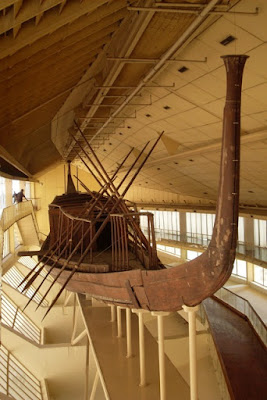
I often encourage visitors to Giza to take time to explore this vast desert cemetery. Not only will the diversion liberate one from the tumultuous hubbub that comes with Giza’s main attractions, but you’ll also come away with a good impression of the scale of the wealth and power commanded by these faithful officials, many of whom would have had a significant hand in the construction of their kings’ pyramids.
Another unmissable attraction on the Giza plateau is the museum installation that now stands on the south side of the Great Pyramid. This most recent of additions to the Giza landscape was purpose-built to house one of a pair of magnificent boats discovered at this very spot in 1954. Meticulously dismantled by the ancient funerary party, both vessels had been carefully buried in their own rectangular pit, undoubtedly as part of the king Khufu’s burial rites. The burials were then sealed with enormous limestone blocks, weighing up to 16 tonnes, by order of king Djedefre, the son and successor of Khufu.
The Nile was the lifeblood of the Egyptians in ancient times. Not only did its waters irrigate and nourish their annual crops, but it also served as the principal mode of transportation. Even so early in pharaonic history, Khufu’s craftsmen were able to draw upon a long tradition of boat building. Their expert mastery of working in wood is evident in the precision and care taken in the construction of this vessel.
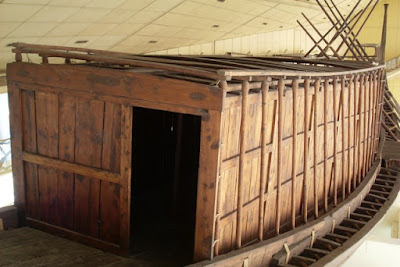
The Boat Museum is designed so that visitors can explore its main exhibit from every conceivable angle. A raised walkway affords excellent views across the deck and inside the cabin. By being in such close proximity, one is really able to get a good idea of how the boat was put together. The entire craft was fashioned from cedar, an intensely aromatic hardwood that was known to have grown only on the distant, mountainous terraces of Syria and Lebanon. Egypt’s indigenous woods, its acacias and sycamores for instance, were found to have been of far inferior quality than the imported cedar timbers. Locally grown trees were really only suitable for much smaller boats. They certainly didn’t grow to the height or strength required for such a large-scale vessel - the keel planks of which alone could measure up to 7 metres. By Khufu’s reign (c. 2470 - 2447 BC), extensive trade routes between Egypt and the coastal ports of Lebanon and Syria were already well-established. A record that has survived from the reign of king Sneferu, Khufu’s father, gives details of a royal trading expedition, probably to the port of Byblos, for the procurement of some forty shiploads of the precious cedar logs.
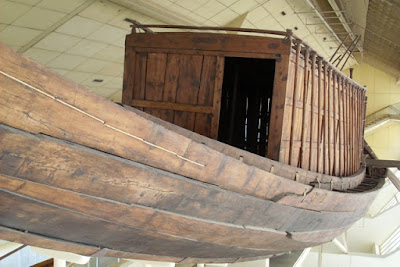
Remarkably, after having been buried beneath the desert sands of the Giza plateau for almost 4,500 years, Khufu’s royal barque remains in a near-perfect state of preservation. Although methodically de-constructed after the king’s interment within the Great Pyramid, the boat would present its modern restorers with a daunting challenge. Faced with a bewildering ancient jigsaw puzzle of over 1,200 individual pieces, it took twenty painstaking years to bring the boat back to life. This labour of love is as much a fitting tribute to the dedication and patience of the restoration party as it is to the skill of the ancient boatbuilders.
The finished boat measures some 43 metres in length and has a displacement of approximately 40 tonnes. It was constructed almost entirely without the need for nails or pegs. Expertly carved, large sections of the planking were bound together using ropes made from vegetable fibres. The deckhouse, constructed from cedar panelling, is 9 metres long and would have been relatively easy to dismantle. Each of the twelve main oars (grouped into six pairs) had been hewn from a single piece of timber. Extremely cumbersome, their weight alone would have probably prohibited them from being used for rowing. It seems that their principal role was to assist in the steering of the boat whilst it was under tow by ancillary vessels.
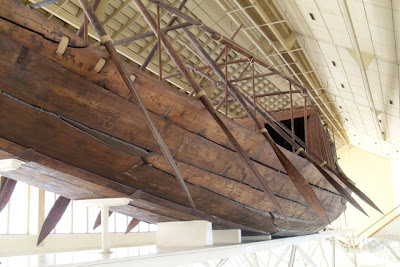
With its tall, slender, papyrus stalks adorning both the prow and stern, the boat is strongly reminiscent of the curved papyrus reed boats of Egypt’s Pre-dynastic period. It may have been the appearance of papyriform boats in ritual contexts that led to the early belief that Khufu’s boats were to be identified with the day and night barques of the sun god. These were the solar vessels that would symbolically elevate the king to the celestial realm, where he would be eternally united with the gods as one of the “Imperishibles”. This was the name that the Egyptians gave to the circumpolar stars. Permanently illuminated in the northern skies, these heavenly bodies were identified as immortal deities.
With their burial so close to that of the king, it is probable that the royal barques had been used for certain ceremonial functions. Displaying none of the decorative features commonly associated with the iconography of solar boats, it seems likely that they were not intended to transport the dead king to his celestial destiny as an immortal being alongside the sun god. It is now more widely proposed in scholarly circles that the buried boats had had a specific ceremonial purpose, having being used in the royal funerary rituals. Although unequivocal proof is not yet forthcoming, Khufu’s boats may well have been employed to transport his mummified body from his palace in the capital of Memphis downriver to the harbour at the pyramid’s valley temple. It would be from here that the king could begin the final stage in his journey to a glorious afterlife.
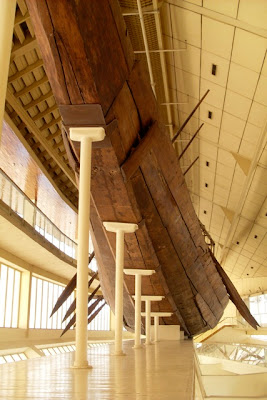
Biography: An audio guide to the Great Pyramid, which includes the Royal Boat Museum, is now on sale at www.iconicguides.com
(Note to Wandering Educators: Here's our review of this Guide!)
Dr Benedict Davies is an Egyptologist, traveller, freelance writer and the founder of MP-3 audio tours “Iconic Guides”. He also holds a PhD in Egyptology from the University of Liverpool and is a leading expert on the community of royal workmen of Deir el-Medina and the Valley of the Kings. A seasoned traveller, Benedict is particularly interested in the culture and art of the ancient Near East and the Far East.
